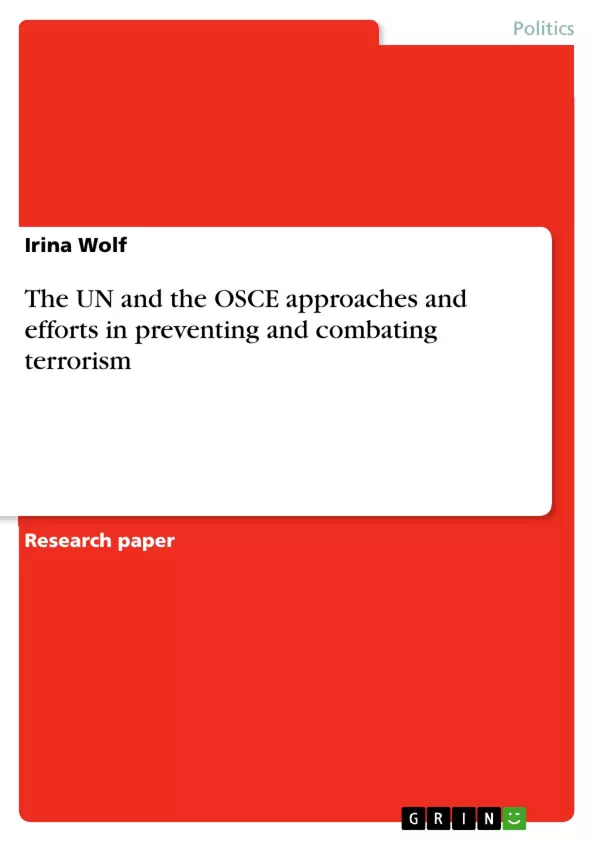The hypothesis of this research is the following. Given the fact that the UN’s documents are legally bounding to the member-states unlike those of the OSCE it seems that the UN is more successful in preventing and combating terrorism. However, whereas the UN uses a legalistic approach to solving this problem the OSCE makes efforts to identify and address root causes, which give rise to terrorism. Taking into account that two organizations closely cooperate with each other in this field it seems that they nicely complement each other. However, since a number of terrorist attacks does not decrease but, on the opposite, increases every day it appears that the organizations should work out a multidimensional strategy in preventing and combating terrorism, which would include a combination of legal, social, economic, cultural, political, and military means.
Inhaltsverzeichnis (Table of Contents)
- Introduction
- The UN's efforts in preventing and combating terrorism
- The legal framework of the UN in preventing and combating terrorism
- The UN's efforts after 9/11
- The OSCE efforts in preventing and combating terrorism
- Conclusion
Zielsetzung und Themenschwerpunkte (Objectives and Key Themes)
This research aims to analyze the approaches taken by the United Nations (UN) and the Organization for Security and Cooperation in Europe (OSCE) in preventing and combating terrorism. The study explores the advantages and disadvantages of each organization in achieving their goals. Key themes addressed in the research include:- The historical development of the UN and OSCE's respective roles in combating terrorism
- The legal frameworks adopted by both organizations in addressing terrorism
- The impact of 9/11 on the UN's and OSCE's anti-terrorism efforts
- The effectiveness of the UN and OSCE's approaches in preventing and combating terrorism
- The potential for future collaboration and coordination between the two organizations in this field
Zusammenfassung der Kapitel (Chapter Summaries)
- Introduction: This chapter introduces the UN and the OSCE as international and regional intergovernmental organizations respectively. It highlights the evolution of these organizations' roles in combating terrorism despite not being originally established for this purpose. The chapter also discusses the difficulty in defining terrorism and emphasizes the need for a common understanding to effectively combat it.
- The UN's efforts in preventing and combating terrorism: This chapter delves into the legal framework established by the UN for combating terrorism. It outlines the 12 conventions and protocols adopted between 1963 and 1999 and discusses their strengths and weaknesses in addressing the issue. The chapter further examines the impact of 9/11 on the UN's anti-terrorism efforts, including the adoption of Resolution 1373 and the establishment of the Counter-Terrorism Committee (CTC).
Schlüsselwörter (Keywords)
This research focuses on the critical themes of international security, terrorism, counterterrorism, international law, legal frameworks, intergovernmental organizations, UN, OSCE, and comparative analysis. The study delves into the effectiveness of legal and political approaches adopted by the UN and OSCE in preventing and combating terrorism, highlighting their strengths, weaknesses, and potential for collaboration.- Quote paper
- Irina Wolf (Author), 2005, The UN and the OSCE approaches and efforts in preventing and combating terrorism, Munich, GRIN Verlag, https://www.grin.com/document/130075



